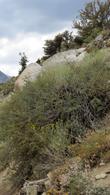Purshia tridentata
Antelope Bitterbrush.
Antelope Bitterbrush is a gray small-leaved shrub to six feet. You will generally see it only 4-5 foot tall. Antelope Bitterbrush grows on dry slopes, east Sierra Nevada, Tulare Co. North, 3000-10000ft. Give it full sun and dry conditions, but in a normal yard will tolerate some water and shade. Antelope Bitterbrush is an important browse plant. (Do not use in high deer area.) The seeds are food for birds and chipmunks. Chipmunks appear to be the main dispersal agents(I always picture chipmunks in trenchcoats carried seeds around.) It is not at its best in coastal gardens. This plant should be used as the border shrub in the deserts. We've had no problems with it and it has looked good here. It and its cousin both will lose their leaves if you put them under drought stress. Don't fret, they'll come back when they get a little water again. These are nice plants and I have no idea why no one is using them in formal or informal plantings. They look a lot better than most of the shrubs in the trade. They are nitrogen fixing. BUT, best of all they smell really good when they flower, the clean mountain scent.
Purshia tridentata is great for a bird garden.
Foliage of Purshia tridentata has color gray and is evergreen.
Flower of Purshia tridentata has color white and has a fragrance.
Communities for Purshia tridentata:Great Basin Sage, Pinyon-Juniper Woodland, Sagebrush Scrub, Sub-Alpine Forest and Yellow Pine Forest.
| ph: | 6.00 to 7.50 |
|---|---|
| usda: | 5 to 10 |
| height[m]: | 1.00 to 2.00 |
| width[m]: | 1.00 to 3.00 |
| rainfall[cm]: | 48.00 to 101.00 |





